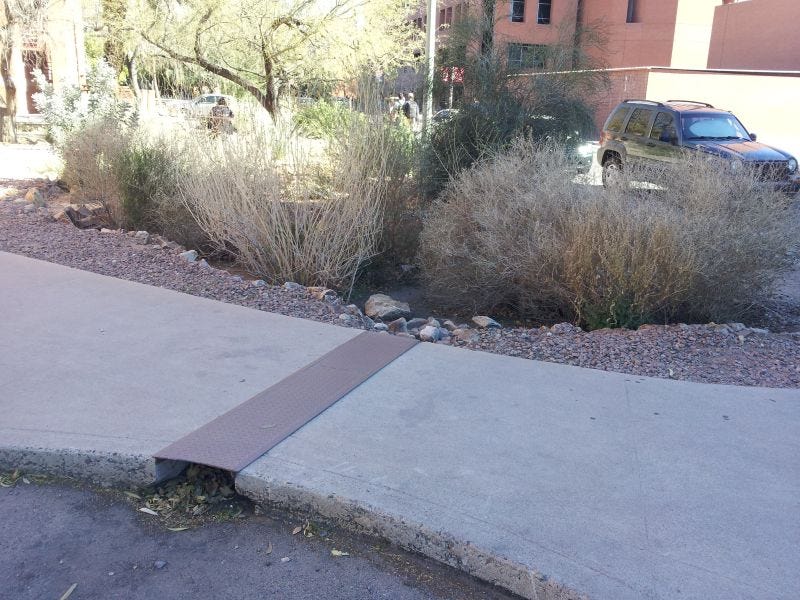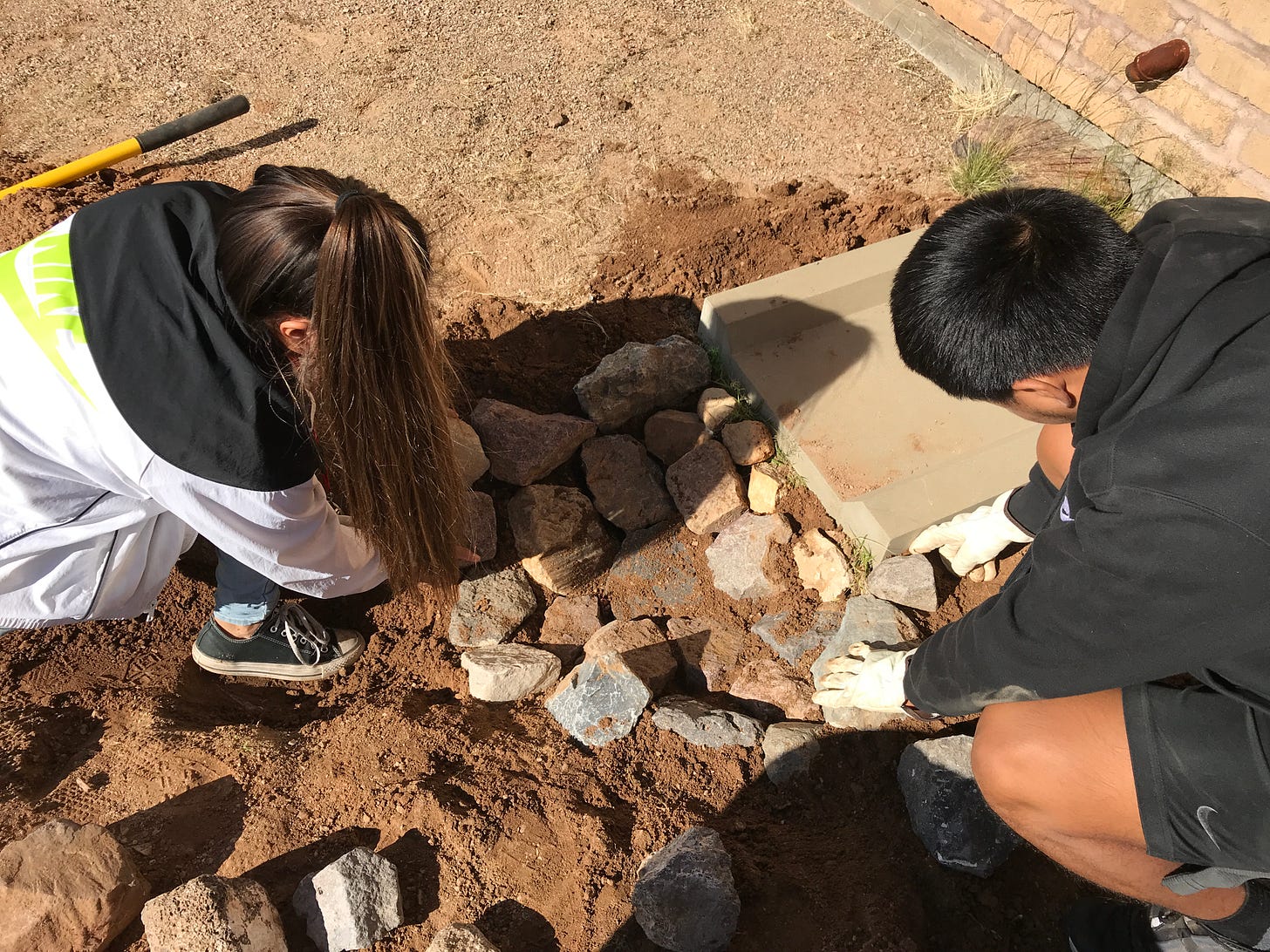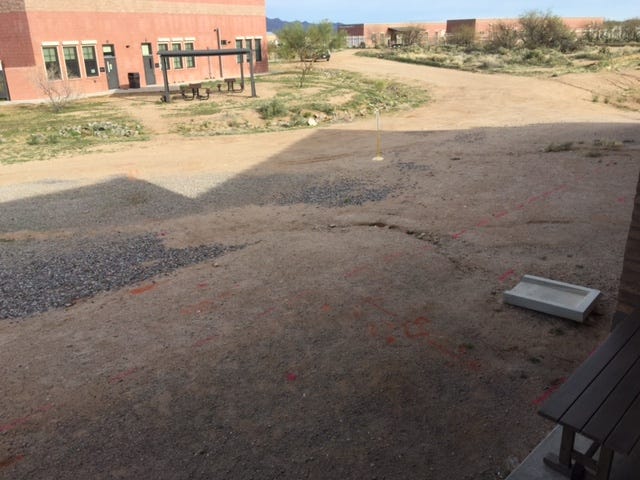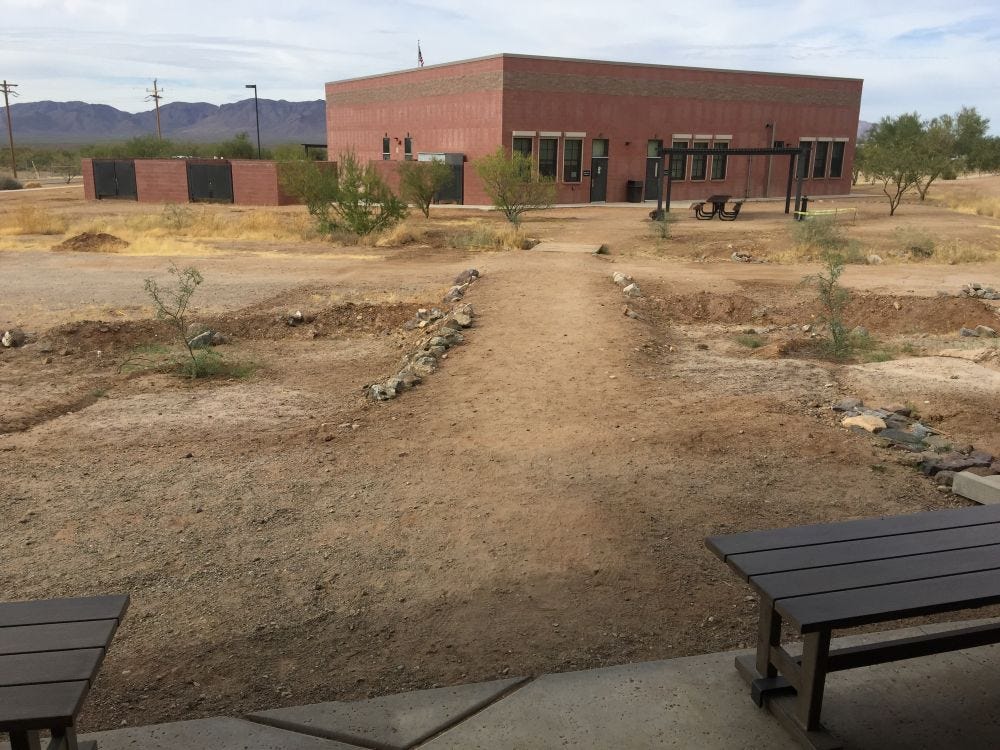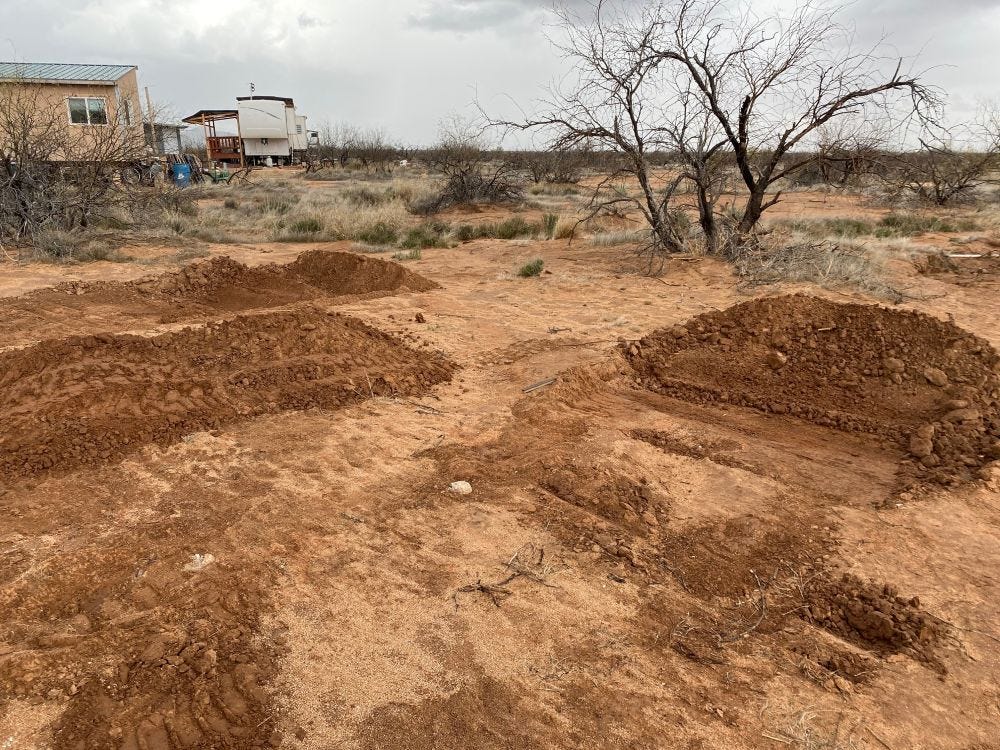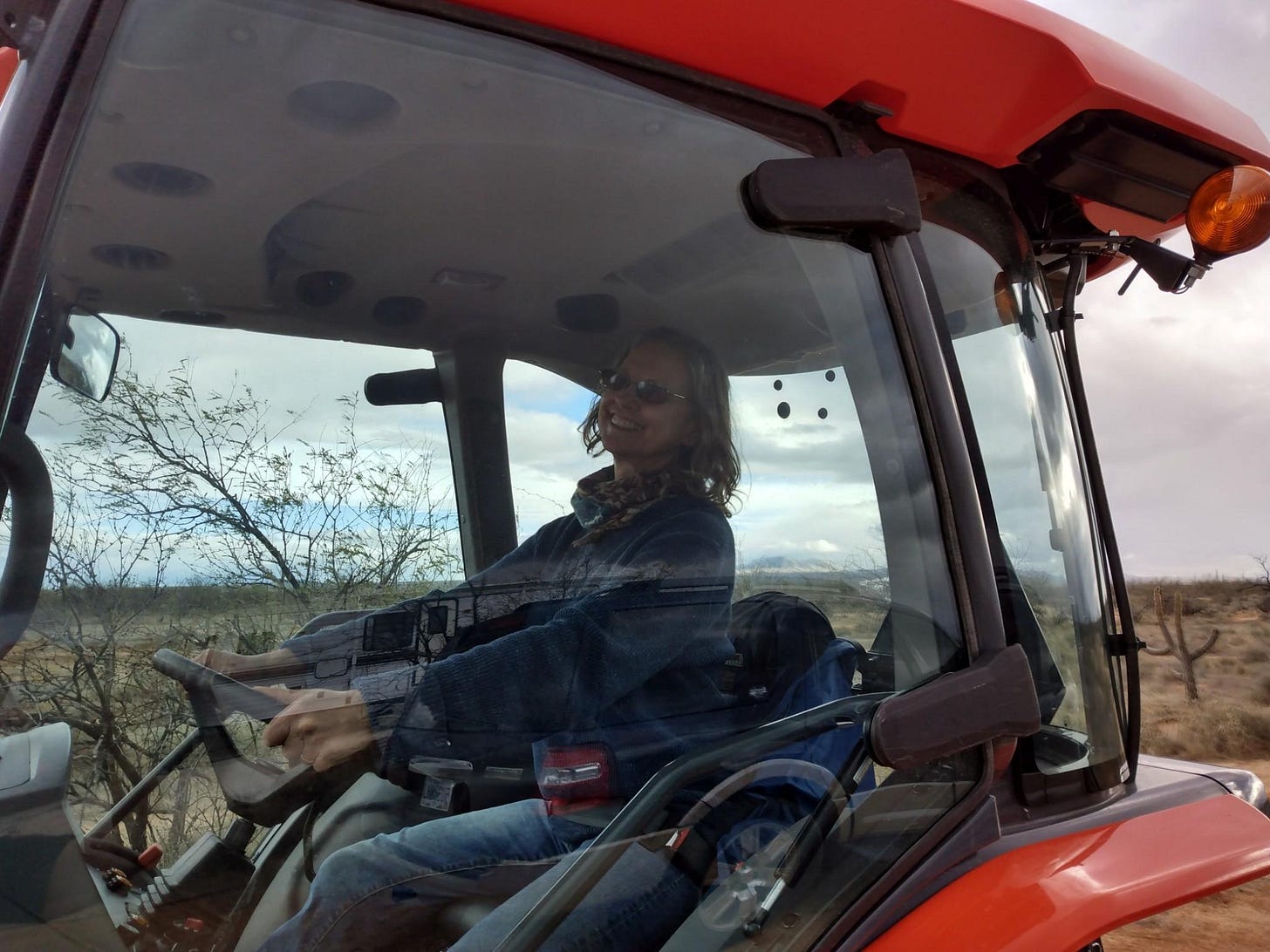How I learned to love bulldozers
Monday Musings: Heavy machinery can help with water harvesting
Photo by Bob Segal
When I was in third grade, hundreds of us filled the seats of the school theater to watch a film. In one scene, yellow ducklings in a marsh ran frantically away from a huge bulldozer. I cringed in my seat near the front, imagining the baby ducks’ terror.
The scene seared into my younger self a desire to protect the baby ducks of the world, and nature in general, from destruction at the hands of humans. Especially when bulldozers were involved.
This became a touchstone for choosing a profession. After spending some time in the trenches as a reporter, I became an environmental journalist. When I realized I wanted to delve deeper into how forests help moderate climate change, I returned to grad school and became an environmental scientist.
Neighbors who care
Upon my arrival in Tucson to attend the University of Arizona, I lived in Dunbar Springs—a neighborhood filled with people who really cared about the environment. I shared a home affectionately dubbed Geckohaven on a slice of land my skilled friends had turned into an urban oasis.
There and in subsequent Tucson dwellings, many of my neighbors promoted tree planting, permaculture and water harvesting. It was a pleasant backdrop to my academic studies and then postdoctoral work at the university.
Over time, though, I found academic life a bit abstract for my tastes. I wanted to do more practical work.
So I pursued a permaculture design certificate. It involved learning about low-impact techniques such as planting “companion” crops together for mutual benefit, eyeing native species for food, and harvesting rainwater to support plants.
I especially loved the water harvesting work.
In a desert, why let water flow and disappear when you could capture some of it to support plants and trees? An undulating landscape did a much better job of puddling water than a flat one.
Everywhere I walked, I would imagine adding raised paths or berms to shed water, and rock-lined basins to hold water.
Water will always flow to the lowest point on the landscape, so sidewalks and raised paths will shed water while basins collect it. Photo by Melanie Lenart
Designs for water harvesting
The permaculture design certificate soon helped me qualify to co-teach a Water Harvesting course with a colleague, Grant McCormick, at the University of Arizona. A background in forestry also helped, as did my doctoral training from geomorphologists, with their focus on the shape of the landscape.
I loved working outdoors with students, implementing our designs as we dug swales to direct water toward our plants, made basins to hold them, and planted seeds and trees.
Our basins were deep enough that we often hired someone to do some bulldozer work before we would refine their shape and embed rock to prevent erosion.
My mind softened a bit to the role of bulldozers.
After a few years of this, I took on a faculty position at Tohono O’odham Community College. I was able to incorporate some water harvesting design into the Water Resources course I now taught at the tribal college.
Students at Tohono O’odham Community College embed rock to prevent erosion. Photo by Melanie Lenart
Co-teaching a course in Agroecology gave me the chance to work closely with Clifford Pablo, a TOCC Extension professional with expertise in organic farming starting from the time he was a child learning from his grandfather.
I began to notice that even the practices I had admired in permaculture could be traced back to Indigenous cultures—in the case of Tucson practices, often the Tohono O’odham.
Those mesquite pancakes with prickly pear syrup served at the Dunbar Springs annual breakfast? The Tohono O’odham had been harvesting mesquite pods to grind them up for flour for centuries. Ditto prickly pear. Ditto buds from cholla cactus.
The same could be said for planting companion crops in clusters together. Many Indigenous peoples plant the “Three Sisters”—corn, beans and squash—together, in ways that complement each other’s growth.
Water harvesting techniques to direct water to crops or trees? Another thing the O’odham were already doing before the term “permaculture” passed across anyone’s lips.
Landscape repairs
One semester, I worked with the Water Resources students and Clifford and his agricultural interns on a project to plant pod-bearing native trees intermingled with some heritage pomegranate trees.
We wanted to beautify the landscape, adding shade and future fruit to the sloped embankment hosting the newly constructed faculty building, the Ha-Mascamdam Ha-Ki.
The path from a newly constructed building was potentially dangerous to traverse. Photo by Melanie Lenart
The building construction had included almost no landscaping. Departing the faculty building by the door closest to the classrooms required a walk down an uneven slope, risking a twisted ankle. So our design included a walkway to the other buildings.
Clifford and his interns were in charge of moving the many tons of soil to form the walkway with heavy machinery—the kind of equipment I would have called a bulldozer. Now I’ve learned to call it a backhoe, because it lifts and moves soil better than the less flexible bulldozer.
The work involved a lot of finessing, such as watering down the soil after every six-inch gain in height to make sure it compacted evenly.
When they were done, the walkway looked beautiful—as much as a smooth stretch of dirt could—and served us all well on our daily treks to and from our offices.
Clifford Pablo and his interns created a raised path that sheds water into the basins on either side. Photo by Melanie Lenart
The final leap
Perhaps all of this eased my mind about what it still wanted to call bulldozers. At any rate, I found myself now wanting to learn how to use heavy machinery.
I got a chance to do so in the larger community’s annual repairs of the unpaved main road we all used to access our homes. It wasn’t as easy as I had hoped, but it was exciting when I started getting the hang of removing the sand that had piled up on the road.
Then I convinced our southern neighbor that the road to their land had strayed far from what the easement on our parcel allowed. After months of negotiating, we agreed I could shorten the turn to his property and reclaim some of the compacted land for planting.
Preliminary basin work on some of the compacted land formerly used for a road. Photo by Melanie Lenart
I worked with other neighbors to split time and cost on a planned weekend rental of a backhoe to help me with this work. I dug some big basins, and used the removed soil to build some berms and a platform that could help keep a parked car or RV out of the floodplain flow.
I enjoyed the feeling of wielding a shovel hundreds of times heavier than I could hold without mechanical assistance—especially in the name of reclaiming some land wasted on an overly large dirt road.
We planted some native trees there—palo verdes, an ironwood and a desert willow—and also distributed some seeds for native flowers. A couple of years later, the willow has grown impressively, the palo verdes are stable, and flowers bloom.
The palo verde tree in the front and desert willow in the back are replacing part of a former dirt road. Photo by Melanie Lenart
We don’t have any ducks around here, but a few days ago I saw a family of quail crossing the area.
Despite the use of heavy machinery, I think my third-grade self would approve.
Me, enjoying the ability to move soil without straining my back. Photo by Bob Segal





